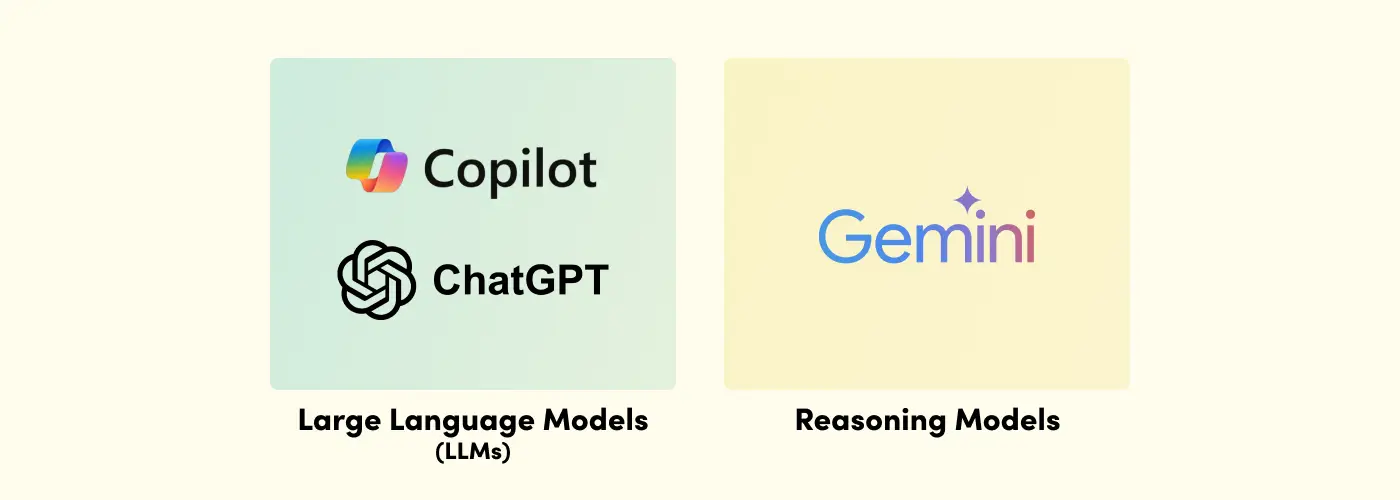Stop using the wrong AI platforms: LLMs vs. Reasoning Models
WRITTEN BY

Keith Martinot
Business Development Manager
QUICK SUMMARY
Our Business Development Manager Keith Martinot explores the differences between large language models (LLMs) and reasoning models and how businesses can strategically implement AI platforms to drive measurable results.



With the recent popularity of artificial intelligence platforms, more and more businesses are turning to AI to improve processes, enhance customer experience, and make more strategic business decisions. However, not all artificial intelligence platforms are created equal. Most people are unaware that today’s leading AI tools, like OpenAI’s ChatGPT or Microsoft’s Copilot, rely on large language models (LLMs) instead of more advanced reasoning models. The differences in how these models generate and reason through responses are subtle yet profoundly impact the quality and reliability of their output.
So what are the key differences between an LLM and a reasoning model? When should your business choose to leverage each model? Let’s explore what sets LLMs apart from reasoning models and how choosing strategically can transform your investment in artificial intelligence into successful real-world results.
What is a large language model (LLM)?
A large language model or LLM such as ChatGPT or Microsoft CoPilot focus on language generation and understanding—largely outputting conversational interactions.
These models are particularly effective at crafting personalized communications, producing detailed reports and summaries, and automating customer support interactions.
What is a reasoning model?
On the other hand, reasoning models such as ChatGPT o3 or Google Gemini 2.5 Pro provide an additional layer of capability by offering logical inference, structured problem-solving, and complex decision-making.
These reasoning models excel at solving intricate puzzles or complex logic problems—providing strategic recommendations and optimizing operational workflows based on analyzed data.

When should I use an LLM vs. a reasoning model?
In practical business scenarios, choosing the right model can significantly influence your outcomes. For example, LLMs may be ideally used for professional communications or outbound messaging where personalized, authentic, and engaging messaging is crucial. LLMs also shine when used for marketing automation to effortlessly create a variety of messages for different audience segments or rapidly generate content for articles, newsletters, and organic social media posts.
Conversely, reasoning models are actually better suited for problems that require complex decision-making and strategic analysis. For example, businesses facing supply chain challenges can benefit greatly from using reasoning models to determine the most efficient and cost-effective routes for inventory management. Similarly, reasoning models also thrive at risk assessment by evaluating financial reporting data, identifying potential risks to business operations, and recommending practical mitigation strategies.
Why does strategically implementing artificial intelligence models matter?
Without a clear understanding of which artificial intelligence models to use that best address certain problems and challenges, businesses risk wasting significant time, resources, and financial investment in platforms that deliver suboptimal results.
Today, strategic implementation of AI platforms isn’t just about gaining an edge—it’s increasingly becoming vital to business survival.
Is your business ready to harness the power of artificial intelligence into actionable insights that drive real-world success?
From rapid product development in just days using our vibe sprint approach to our upcoming digital workplace maturity assessment, our new AI-powered products can help take your business to the next level. If you’re interested in learning more, fill out the form below to get started!






